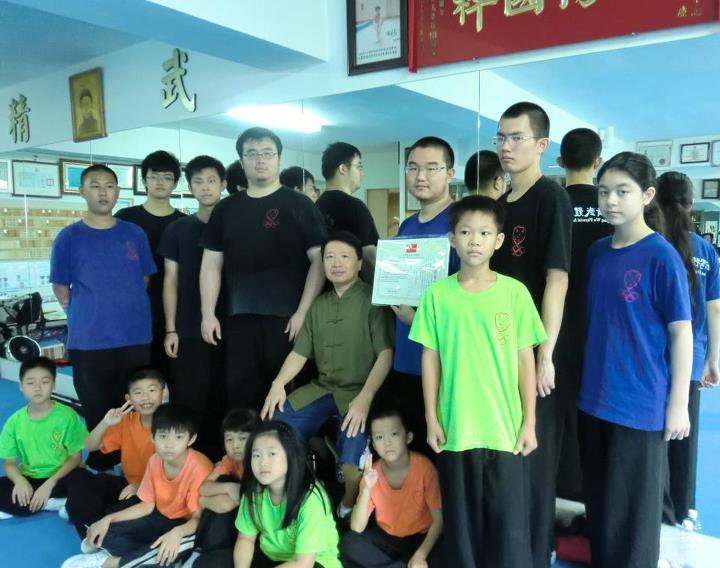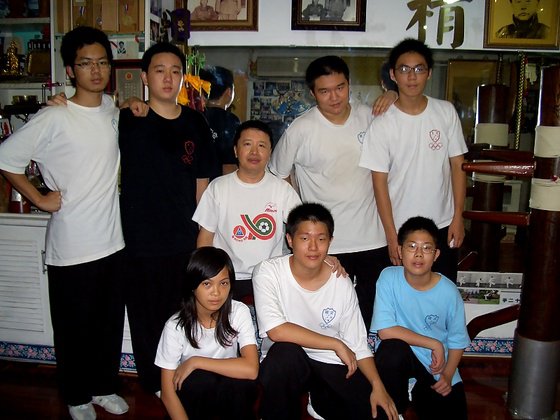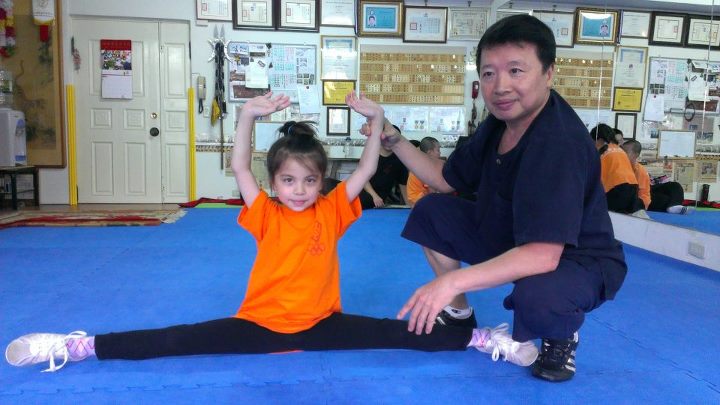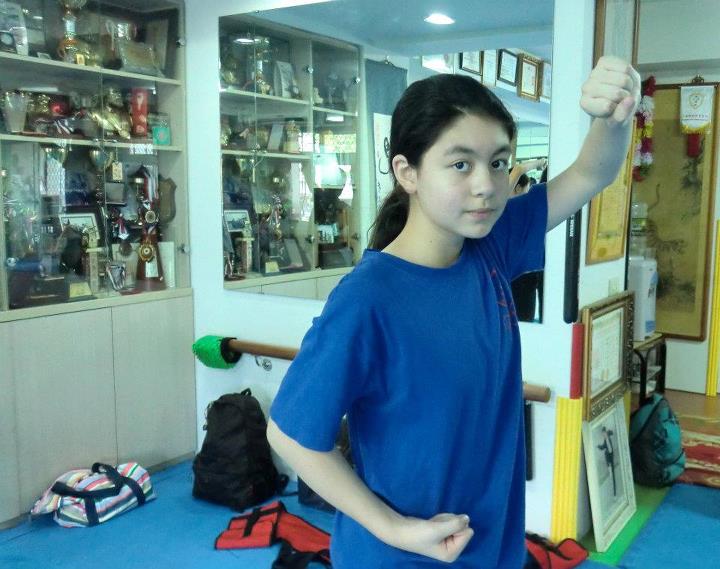



 中國武術,是中華民族創造和發展起來的,具有健身、護體、防敵、制勝的作用,被稱為中國四大國粹之一,為各族人民所喜聞樂見。
中國武術,是中華民族創造和發展起來的,具有健身、護體、防敵、制勝的作用,被稱為中國四大國粹之一,為各族人民所喜聞樂見。
武術在中國具有悠久的歷史。武術的起源可以追溯到原始社會,原始人使用棍捧、石器等同野獸搏鬥。學會了一些基本的格鬥和搏殺技能。原始戰爭的出現,單人應戰技能得以完善。先秦時期,各國諸侯都非常重視培養和訓練將士們的搏擊技術,劍術得到發展。漢代,帶有搏擊性質的“角抵”已有廣泛的基礎,還發明了鐵兵器,出現了編排起來的攻防連續套路。到了晉代,練武活動已有“口決要術”,武術初見雛形。唐代,是中國武術的興盛時期,唐武則天開武舉,不少武術人才脫穎而出,天下聞名的少林武術的最早記載也起於唐朝初年。宋代,中國武術走向成熟。健身練武已成為志士仁人生活的重要內容。而且,在民間還組成了研習武藝的組織 “社”,開始出現武術的一些流派。元代出現了某些以傳授武藝為主要內容的武館。明清時期,民間習武更為廣泛,門派林立,出現了數百種武術套路,武術流派趨於定型。
中國武術具有獨特的風采。武術的主要內容由拳術和器械的套路組成。根據拳種和類別的不同,套路有長有短,有剛有柔,有單練,有對練,風格不同,表現各異。但共同的要求是動作連貫、往返多變、起伏轉折、快速敏捷、節奏鮮明。在武術的動作和練法中,都具有攻防的作用,如踢、打、摔、拿、擊、刺等動作,是組成武術套路運動的主要因素,它們都有著不同的演練特點和攻防規律。中國武術具有形神兼備、內外合一的神韻,由於武術動作是從格鬥攻防技術中提煉出來的,因此要求手到眼到,手疾眼快;手腳相隨,上下協調;意領身隨,以氣催力;意識、呼吸、動作必須和諧一致。在中國武術的長期發展中,逐漸演化出十八般武藝或十八般兵器。通常認為十八般兵器包括:“刀槍劍戟、斧鉞鉤叉、棍槊棒、鞭 錘抓、拐子流星”。中國古代的兵器遠不止這18種,平常所說的十八般兵器或武藝只不過是一種汎稱。



 中國武術文化底蘊豐富,門類眾多。按流行地區分類,劃分為南拳、太極拳;按山脈、廟宇分類,可劃分為少林拳、武當拳、峨眉拳;按形象分類,可劃分為蛇拳、猴拳、螳螂拳等;按技術內容分類,劃分為拳術類、器械類、氣功類、摔跤類等。拳術類包括長拳、太極拳、南拳、形意拳、八卦拳、通臂拳等。器械類包括刀術、劍術、槍術、棍術四大主要形式。氣功類包括禪家、道家、儒家、醫家和拳家五大派別。摔跤起源於中國古代的角力和相撲,現稱為中國式摔跤。
中國武術文化底蘊豐富,門類眾多。按流行地區分類,劃分為南拳、太極拳;按山脈、廟宇分類,可劃分為少林拳、武當拳、峨眉拳;按形象分類,可劃分為蛇拳、猴拳、螳螂拳等;按技術內容分類,劃分為拳術類、器械類、氣功類、摔跤類等。拳術類包括長拳、太極拳、南拳、形意拳、八卦拳、通臂拳等。器械類包括刀術、劍術、槍術、棍術四大主要形式。氣功類包括禪家、道家、儒家、醫家和拳家五大派別。摔跤起源於中國古代的角力和相撲,現稱為中國式摔跤。
在中國 武術發展史上,最為著名的武術流派是少林派、武當派和峨眉派。
(1)少林武術。發源於河南嵩山少林寺。少林武術內容極為豐富,其中少林拳的精華被稱為“少林五拳”,系指龍拳、虎拳、豹拳、蛇拳和鶴拳,分為小洪拳、大洪拳、羅漢拳、梅花樁砲搥等幾十種少林拳法,還有刀、槍、劍、鏟、棒等器械的技擊法,並創造出少林易筋功、小武功、陰陽功、混元一氣功等氣功。少林拳在一千多年的發展中,逐漸分為北派少林拳和南派少林拳。
(2)武當武術。因發源於湖北均縣境內的武當山而得名。武當武術起源于元末明初,盛行于明末清初。武當拳的風格特點是以靜製動,以柔克剛,以短見長,以慢擊快,以意運空,以氣運身。武當派拳術有無極拳、鷂子長拳、猿猴伏地拳、六歲散手和五當太乙五行拳等。武當兵器有武當劍、白虹劍、六合槍、六合刀、松溪棍等。太權拳屬武當著名拳種,影響極大。太極拳在長期流傳中,演變出許多支派,其中流傳最廣、影響最大的太極拳有陳式太極拳、楊式太極拳、吳式太極拳、武式太極拳和孫式太極拳。後經提煉整理,又出現簡化太極拳、四十八式太極拳、八十八式太極拳等套路。
(3)峨眉武術。發祥於四川峨眉山,形成於明代。峨眉拳集眾家之長,形成了獨特的技法與風格。它的主要技擊特點是動作小,變化大,以柔克剛,藉力打力,以靜製動和以動製靜並用,攻防時多順勢前鑽,藉力反擊,以快取勝。峨眉拳術有僧門、岳門、杜門、趙門四大家和洪門、化門、字門、慧門四小家,還分為黃林、點易、青城、鐵佛、青牛五大門派。
 此外,氣功與摔跤也在中國武術中佔有一席之地。
此外,氣功與摔跤也在中國武術中佔有一席之地。
氣功是一種祛病健身、益壽延年的養生術和自我身心鍛鍊方法。氣功
在發展中,逐漸與各學說流派相結合。儒家養氣,旨在修身。武術拳家養氣,旨在積氣。醫家養氣,旨在治疾健身。佛家養氣,旨在排除雜念,達到禪定。氣功門派眾多,尤以道家氣功見長。
摔跤是兩人相角的一種武術體育運動,摔跤一般均按體重分級進行,能使對手的身體任何部位(兩腳除外)觸地為勝。摔跤也是中國部分少數民族傳統的體育項目之一,蒙古族、朝鮮族、哈薩克族和保安族等都喜愛摔跤。
中國武術自唐宋後,就逐漸傳向國外。日本、朝鮮、越南及東南亞國家習武者不少,並形成一些武術門派。在歐美國家,中國武術的影響也非常深遠,稱中國武術為“功夫”。很多西方人認識中國文化首先是從了解中國武術開始的。中國武術是中國人民對世界文化的重要貢獻。
中國武術文化特點
(一)寓技擊於體育之中
武術最初作為軍事訓練手段,與古代軍事鬥爭緊密相連,其技擊的特性是顯而易見的。在實用中,其目的在於殺傷、制服對方,它常常以最有效的技擊方法,迫使對方失去反抗能力。這些技擊術至今仍在軍隊、公安中被採用。武術作為體育運動,技術上仍不失攻防技擊的特性、而是將技擊寓於搏鬥運動與套路運動之中。搏鬥運動集中體現了武術攻防格鬥的特點,在技術上與實用技擊基本上是一致的,但是從體育的觀念出發,它受到競賽規則的制約,以不傷害對方為原則。如在散手中對武術中有些傳統的實用技擊方法作了限制,而且嚴格規定了擊打部位和保護護具,短兵中使用的器具也作了相應的變化,而推手則是在特殊的技術規定下進行競技對抗的。因此,可以說武術的搏鬥運動具有很能強的攻防技擊性,但又與實用技擊有所區別。
(二)內外合一,形神兼備的民族風格及廣泛的適應性
既究 形體規範,又求精神傳意、內外合一的整體觀,是中國武術的一大特色。所謂內,指心、神、意等心志活動和氣息的運行;所謂外,即手眼身步等形體活動。內與外、形與神是相互聯繫統一的整體。武術"內外合一,形神兼備"的特點主要通過武術功法和技法來體現。"內練精氣神,外練筋骨皮"是各家各派練功的準則,武術的練習形式、內容豐富多樣,有競技對抗性的散手、推手、短兵,有適合演練的各種拳術、器械和對練,還有與其相適應的各種練功方法。不同的拳種和器械有不同的動作結構、技術要求、運動風格和運動量,分別適應人們不同年齡、性別、體質的需求,人們可以根據自己的條件和興趣愛好進行選擇練習。同時,它對場地、器材的要求較低,俗稱"拳打臥牛之地",練習者可以根據場地的大小變化練習內容和方式,即使一時沒有器械,也可以徒手練拳、練功。一般來說,受時間、季節限制也很小。較之不少體育運動項目,具有更為廣泛的適應性。/百度



 Chinese martial arts culture to share: Chinese martial arts, is the creation and development of the Chinese nation, with fitness, body care, anti-enemy, winning the role, known as one of China's four national essence, loved by people of all nationalities.
Chinese martial arts culture to share: Chinese martial arts, is the creation and development of the Chinese nation, with fitness, body care, anti-enemy, winning the role, known as one of China's four national essence, loved by people of all nationalities.
The martial arts has a long history in China. The origin of the martial arts can be traced back to primitive society, primitive stick holding stone tools equivalent to the beast fight. Learned some basic fighting and fight skills. The original war, single-man skills to perfect. The Qin Dynasty, the princes of countries attached great importance to the cultivation and training of the soldiers fighting techniques, fencing to be developed. Han Dynasty, with the fighting nature of the angle of arrival has been broad-based, the invention of iron weapons, and appeared in the arrangement of up consecutive offensive and defensive routines. To the Jin Dynasty, the martial arts activities have been "I decided to be technique", the martial arts began to take shape. Tang Dynasty, is the boom years of the Chinese martial arts, Tang Empress Wu open arms held many martial arts talent to stand out, the earliest record of the world-famous Shaolin martial arts since the Tang dynasty. Song Dynasty, the Chinese martial arts and more mature. Fitness martial arts has become an important part of the lofty ideals of life. Moreover, in civil society and had formed a study martial arts organization "Society" and the martial arts genre. The Yuan Dynasty, there have been some martial arts to teach martial arts as the main content. Ming and Qing Dynasties, the broader civil martial arts, martial art everywhere, there have been hundreds of Wushu martial arts schools tend to stereotypes.
Chinese martial arts have a unique style. The main content of the martial arts, boxing routines and equipment. Boxing and different categories, the routines have a long or short, just soft, Danlian right to practice different styles, different performance. But the common requirement is that coherent action, and from the varied, undulating transition, fast and agile, and a distinct rhythm. In the martial arts action and practice it, the role of offensive and defensive, such as kick, hit, throw, take, strike, stab, such action is composed of the main factors of the Wushu forms, they have a different drill features and offensive and defensive law. Has Vivid, inside and outside one of the charm of Chinese martial arts, martial arts action is extracted from the combat offensive and defensive techniques, thus requiring the hand to the eyes, Shoujiyankuai; hands and feet go hand in hand, the upper and lower co-ordination; Italian collar body with gas reminder force; awareness, breathing, action must be harmony. In the long-term development of Chinese martial arts, and gradually evolved into the 18 martial arts, or 18 weapons. Generally considered that 18 weapons, including: "Daoqiangjianji, ax hook Fork, stick lance stick, whip hammer caught, the kidnapper meteor. The ancient Chinese weapons far more than 18 kinds, 18 weapons or martial arts usually referred only to a pan.
Chinese martial arts culture is rich in numerous disciplines. According to the classification of the endemic areas, is divided into fist, tai chi; mountains, temples, classification can be divided into the Shaolin boxing, Wudang boxing, Emei boxing; image classification, can be divided into a snake boxing, monkey boxing, mantis boxing; technical content The classification is divided into boxing class, equipment class, Qigong, wrestling. Boxing classes include the long fist, tai chi, Nan Quan, Xing Yi Quan, Bagua Quan, Arm boxing and so on. Machinery including broadsword, sword, spear, cudgel four major forms of Qigong class, including the home of Zen Buddhism, Taoism, Confucianism, medicine and the boxing home five factions. Wrestling wrestling and sumo originated in ancient China, now known as the Chinese-style wrestling.
In the history of the development of Chinese martial arts, the most famous martial arts schools Shaolin, Wudang and Emei.
(1) Shaolin martial arts. Originated in the Henan Songshan Shaolin Temple. Shaolin martial arts is extremely rich in content, of which the essence of Shaolin boxing is known as the "Shaolin boxing" means Dragon Punch, tiger boxing, leopard boxing, snake boxing and crane boxing, divided into small Fist Fist of Luohan, plum pile gun hammer and other dozens of Shaolin boxing, knife, gun, sword, shovel, rods and other instruments of martial law and create the Shaolin Gong, martial arts, the yin and yang power, Hun Yuan a Qigong Qigong. Shaolin boxing in the thousand years of development, gradually divided into the Northern School of Shaolin boxing and the Southern School of Shaolin boxing.
(2) Wudang martial arts. Originated in Hubei were County Wudang Mountain got its name. Wudang martial arts originated in the Yuan and Ming, was popular in the late Ming and early Qing dynasties. Wudang boxing style characterized by inaction, Yiroukegang short known to slow blow fast to Italy shipped empty to the air transport body. Wudang boxing the Promise boxing, kite changquan, apes and bowed to the ground boxing-year-old Sanshou and five Taiyi element boxing and so on. Wudang weapons Wudang sword, white rainbow sword, Kuni gun, Kuni knife, Songxi stick and so on. Taiquan boxing is famous Wudang boxing, a great impact. Tai chi in the long-term spread, the evolution of many tribes of which the most widely circulated and influential Tai Chi Chen Style Tai Chi, Yang style Tai Chi Chuan, Wu Style, Wu style Tai Chi Chuan and Sun Style. After refining sorting, and Simplified Tai Chi Chuan, 48-style Taijiquan, 88 type shadowboxing routine.
(3) Emei martial arts. Originated from Mount Emei, Sichuan, formed in the Ming Dynasty. The Emei boxing collection of many long, forming a unique technique and style. Its main martial art is characterized by small movements, changes, softness, leveraging the power of inaction and static and dynamic system, attack and defense more advantage of the opportunity before drilling, leveraging counterattack fast win. Emei martial arts monk door, Yue Mun, Truman, Zhao door and freemason of the door, the word door, Hui door home, but also divided into Lin Huang Yi points, Qingcheng, Tiefo,, blue bull and five martial art .
In addition, qigong, and wrestling are also Chinese martial arts place.
Qigong is a healing and fitness, longevity, health preservation and self physical and mental training methods. Qigong
Gradually with the theories and doctrines in the development of a combination. Confucian Yang Qi, aimed at self-cultivation. Martial arts boxing domestic gas, designed the product gas. Medical domestic gas, designed to cure disease fitness. Buddhist raise gas, designed to eliminate distractions, and to achieve meditation. Many Qigong, known especially Taoist Qigong.
Wrestling is a two phase angle of a martial arts sport, wrestling in general according to body weight classification, and make the opponents of any part of the body (except feet) touchdown for the win. One of the traditional sport of wrestling is also part of the minority, Mongolian, Korean, Kazakh, and Bonan so fond of wrestling.
Chinese martial arts since the Tang and Song dynasties, gradually transfer to foreign countries. Japan, Korea, Vietnam and Southeast Asian countries, martial arts are many, and the formation of a number of martial arts. In the United States and Europe, Chinese martial arts are very far-reaching, said the Chinese Martial Arts Kung Fu. Many Westerners to understand Chinese culture first of all start from the understanding of Chinese martial arts. Chinese martial arts is an important contribution to world culture of the Chinese people.
Cultural characteristics of Chinese martial arts
(A) blending martial in Physical
Martial arts as a means of military training initially, and the ancient military struggle closely linked to the characteristics of their martial art is obvious. In the utility, its purpose is destruction, uniforms each other, it is often the most effective martial art method, forcing the other to lose the capacity for resistance. These martial surgery is still the military, public security in using. The martial arts as a sport, is still technically without losing the characteristics of defending and attacking, but the martial art resides in the struggle movement and routine movement. Embodies the characteristics of the martial arts of offensive and defensive fighting fight sport, technical and practical martial art is basically the same, but starting from the concept of sports, it is constrained by the competition rules, the principle not to hurt each other. Such as casual hands of some traditional martial arts and practical martial art methods limit the strict rules that hit parts of the apparatus used in the protective brace, short soldiers made the appropriate changes, push hands is in the special technical provisions under the competitive confrontation. Therefore, we can say that the martial arts, wrestling sport has a very strong defending and attacking, but with the practical art of attack and different.
(B) internal and external integration, the Vivid ethnic styles and a wide range of adaptability
Both studies the physical specifications, but also to seek the spirit of the Communication, internal and external integration of the overall concept, is a major feature of the Chinese martial arts. Within the so-called, refers to the heart, God, Italian and other efforts toward activities and atmosphere of the operation; the so-called foreign hand-eye body step, and other physical activities. Inside and outside, form and spirit are interrelated and unified whole. Martial arts internal and external integration Vivid features to reflect primarily through martial arts exercises and techniques. Practice Manner in training the bones and skin "is the criteria of the various factions practice martial arts exercise form, content rich, competitive antagonistic Sanshou, pushing hands, short soldiers, there are a variety of martial arts for exercise equipment and training, as well as compatible with a variety of practice methods. Boxing and equipment have different structure for action, technical requirements, movement style and amount of exercise, respectively, to adapt to the needs of people of different age, gender, physical, people can choose to practice on their own terms and interest in hobbies. Meanwhile, the lower its space, equipment requirements, commonly known as "the land of the punch wau, practitioners can practice according to the size of the venue change the contents and form, even if the moment there is no equipment, can also be unarmed martial art practice. In general, by the time the season limit is also very small. Compared to many sports projects, with a wider range of adaptability. / Baidu 



 留言列表
留言列表


